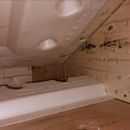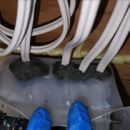Energy efficient shed update and some questions about sealing vapor barrier
The insulated shed project is moving along now. The goal is to build a 100 sq ft shed in a climate similar to Seattle (but in Canada,) that I can reliably keep above freezing all winter long with just a light bulb.
I did electrical and most of the insulation today. I’ll be using Tyvek on the outside and a vapor barrier on the inside wall.
Those poly hats designed to be used with metal electrical boxes are a real PITA. I used duct seal to seal the holes in the poly hat. Is that an appropriate product for that purpose?
In the attic, I had some leftover baffle material so I cut it in half to make some small half-baffles that I stapled to the top plate as a minor wind-wash guard. I don’t need to worry about the Rockwool batts moving but this should help minimize cold air blowing directly under them.
I’m reasonably happy with how the insulation is going. My truss design is a simple triangle. It extends beyond the edge of the top plate so I had room to do R28 from the outside of the wall. It is R56 in the middle (about 6″ inside the inside wall). I wish I had the foresight to fill that missing triangle but I was making it up as I went and there is no easy way to do it now.
Tomorrow, I install the vapor barrier. I’m trying to figure out when and where I need to use acoustic sealant. I’ve never used it before but it sounds very messy. Where should I use acoustic sealant instead of tuck tape?
GBA Detail Library
A collection of one thousand construction details organized by climate and house part












Replies
C_D,
As rule of thumb the (blue) tuck-tape gets used to join the vapour barrier and for larger penetrations, while acoustical sealant goes where the VB meets another material. So tape on seams, sealant around the RO of windows and the intersection of the floor and walls. However you can use tape on these areas and eliminate the sealant altogether if you'd like.
Those clear boots are difficult to use and seal effectively. You will find the plastic gasketted ones much easier.
Thanks Malcolm,
For wall/ceiling joint, what would you recommend? I could do the wall first with acoustic sealant at the bottom plate and top plate. I could then do the ceiling with some overhang of the poly and use tuck tape between the ceiling and wall poly?
I've had some bad experiences with plastic boxes in the past (those cheapo little plastic tabs break off and it's trickier to pull the cable out of your courtesy loop when doing future work) so I try to use metal. I also have a non-standard wall thickness on this project (1/4"). In retrospect, I agree that the plastic boxes are the way to go. Would you ever use duct seal in the plastic boxes where the cables come in for an even tighter seal?
C_D,
Make sure all your overlaps fall on solid backing, then tape the seam. The interior finish (drywall?) will compress the joint keeping things tight.
Use acoustical sealant sparingly. It smells, and no matter how careful you are ends up on everything. That's a temporary annoyance when it ends up on your clothes, tools and truck seat, but it also stays pliable indefinitely, so when you go to lay flooring down the road, and it starts migrating on to it and the trim, you will wish you had used tape.
I do a fair number of renovations on old(ish) houses. The 25 year old clear silicone caulking I pulled from around the exterior of windows last week was still stuck tenaciously. I don't think it makes much difference what you use to seal the holes in electric boxes.
One advantage of having your primary air-barrier at the sheathing rather than the interior of the walls, is that you don't need to worry as much about penetrations, and can leave courtesy loops on your wires for future use.
I don't recommend using acoustical sealant at all. In addition to Malcolm's cautions, it continues to smell for months, and the contents include residual sludge left over from oil refining (literally) that include unknown toxins. Contega HF is a product with similar functionality that is still a little messy, but it's much less toxic, barely smells at all, and stops smelling after some hours instead of months.